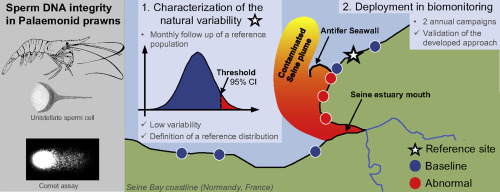Water Research ( IF 11.4 ) Pub Date : 2017-12-27 , DOI: 10.1016/j.watres.2017.12.057 Alexandre Erraud , Marc Bonnard , Arnaud Chaumot , Olivier Geffard , Aurélie Duflot , Joëlle Forget-Leray , Frank Le Foll , Alain Geffard , Benoit Xuereb

|
In a previous study, the Comet assay was optimized for Palaemon serratus prawns in order to propose a biomarker for sperm quality in this species. However, better knowledge of its basal level and its natural variability, related to intrinsic biotic and environmental abiotic factors, is required before any relevant use of this biomarker in the field. To fulfill this goal, the present study proceeded in three steps: (i) the temporal variability of DNA integrity was followed monthly in a reference population over a 2-year period, (ii) the correlation between the main intrinsic biotic (i.e. size, weight and molting stage) and abiotic factors (i.e. water temperature) were recorded in the field, and the basal DNA integrity was assessed in order to scrutinize any confounding influence of factors unrelated to toxic response, (iii) the baseline level was used to discriminate biomarker response among different stations displaying contrasting contamination levels. The results of the two-year monitoring in the reference population revealed no correlation between the levels of spermatozoa DNA damage and temperature, body size, weight or molting stage. Only a slight variability between monthly samplings was detected. On the basis of these field-collected data, we defined a reference distribution (i.e. 52.6 ± 5.6 A.U) with a threshold value (i.e. 61.7 A.U). Finally, this threshold value proved its relevance to discriminate among stations with contrasting pollution levels around the Seine Bay. Indeed, the results suggest significant DNA damage in populations nearest the Seine estuary, a major source of contaminants in the Bay, and a lower effect in populations further away from the estuary. The overall conclusion was that the Comet assay on P. serratus spermatozoa could be a useful tool for the monitoring of the toxicological print within sperm and main globally the contamination exposure of crustaceans in marine waters.
中文翻译:

精子DNA完整性作为暴露于锯齿龙(Pennant 1777)中污染物的标志物:内在变异性,基线水平和原位部署
在先前的研究中,彗星测定法已针对锯齿Pala进行了优化虾,以便为该物种的精子质量提出一种生物标记。但是,在本领域对该生物标记物进行任何相关用途之前,需要更好地了解其基础水平及其与自然生物和环境非生物因素有关的自然变异性。为实现这一目标,本研究分三个步骤进行:(i)在2年的时间里,每月对参考人群的DNA完整性进行时间变异性跟踪;(ii)主要内在生物之间的相关性(即大小,在野外记录体重和蜕皮阶段)和非生物因子(即水温),并评估基础DNA的完整性,以便仔细检查与毒性反应无关的因子的任何混杂影响,(iii)使用基线水平来区分表现出不同污染水平的不同站点之间的生物标志物响应。在参考人群中进行的为期两年的监测结果表明,精子DNA损伤程度与温度,体型,体重或蜕皮阶段之间没有相关性。在每月采样之间仅检测到微小的变化。基于这些现场收集的数据,我们定义了具有阈值(即61.7 AU)的参考分布(即52.6±5.6 AU)。最后,该阈值证明了在区分塞纳湾周围污染水平不同的站点之间的相关性。实际上,这些结果表明,离塞纳河口最近的人群中的DNA遭到了严重破坏,而塞纳河口是海湾的主要污染物来源,并且在远离河口的人群中影响较小。总体结论是彗星实验锯缘青霉(P. serratus spermatozoa)可能是监测精子内毒理学印记的有用工具,并且在全球范围内主要是对海水中甲壳类动物污染的暴露。









































 京公网安备 11010802027423号
京公网安备 11010802027423号